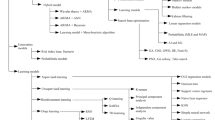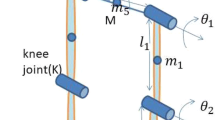Abstract
In this paper, an on-line gait control scheme is proposed for the biped robots for walking up and down the stairs. In the proposed strategy, the nonlinear model predictive control approach is used for the trajectory planning and as well as for the control of the robot. The motion of the robot is expressed in the form of a cost function and some constraints that are related to the stable walking of the robot. The main feature of this method is that it does not need any off-line trajectory planning and the walking gait is formulated such that the environmental and stability constraints of the robot are satisfied. This on-line trajectory planning gives the important ability to the robot to adjust its gait lengths. In this way, the robot is able to ascend and descend the stairs without knowing the height and depth of the stairs in advance. In the control algorithm, the Radial-Basis Function (RBF) neural network with on-line training method is used to model the behavior of the robot over the prediction horizon. The stability analysis of the closed-loop system is performed using the Lyapunov method as well as the Poincaré map. The proposed method is applied to a 5-DOF biped robot in the sagittal plane. The simulation results show effectiveness of the proposed method.
Similar content being viewed by others
References
Q. Huang, K. Yokoi, S. Kajita, and K. Kaneko, “Planning walking patterns for a biped robot,” IEEE Transactions on Robotics and Automation, vol. 17, no. 3, pp. 280–289, 2001.
S. Kajita, F. Kanehiro, K. Kaneko, and K. Fujiwara, “Biped walking pattern generation by using preview control of zero-moment point,” Proc. of IEEE International Conference on Robotics and Automation, Taipai, Taiwan, Sept 2003.
C. Zhou and Q. Meng, “Dynamic balance of a biped robot using fuzzy reinforcement learning agents,” Journal of Fuzzy Sets and Systems, vol. 134, no. 1, pp. 169–187, 2003.
J. Y. Kim, I.W. park, and J. H. Oh, “Realization of dynamic stair climbing for biped humanoid robot using force/torque sensors,” Journal of Intelligent and Robotic Systems, vol. 56, no. 4, pp. 389–423, 2009.
C. S. Park, T. ha, J. Kim, and C. H. Choi, “Trajectory generation and control for a biped robot walking upstairs,” International Journal of Control, Automation, and Systems, vol. 8, no. 2, pp. 339–351, 2010.
O. Kwona and K. S. Jeon, “Optimal trajectory generation for biped robots walking up-and-down stairs,” Journal of Mechanical Science and Technology (KSME Int. J.), vol. 20, no. 5, pp. 612–620, 2006.
S. Ito, S. Amano, M. Sasaki, and P. Kulvanit, “A ZMP feedback control for biped balance and its application to inplace lateral stepping motion,” Journal of Computer, vol. 3, no. 8, pp. 23–31, 2008.
P. Sardain and G. Bessonnet, “Force acting on a biped robot. center of pressure-zero moment point,” IEEE Transactions on Systems, Man, and Cybernetics-Part A: Systems and Humans, vol. 8, no. 5, pp. 1061–1071, 2010.
M. Vukobratovic and D. Juricic, “Contribution to the synthesis of biped gait,” IEEE Transactions on Bio-Medical Engineering, vol. 16, no. 1, pp. 1–6, 1969.
C. Fu and K. Chen, “Gait synthesis and sensory control of stair climbing for a humanoid robot,” IEEE Transactions on Electronics, vol. 55, no. 5, pp. 2111–2120, 2008.
Z. Zho, Y. Wang, and X. Chen, “Real-time control of full actuated biped robot based on nonlinear model predictive control,” International Conference on Intelligent Robotics, vol. 5314, pp. 873–882, Wuhan, China, 2008.
H. Diedam, D. Dimitrov, P. B. Wieber, K. Mombaur, and M. Diehl, “Online walking gait generation with adaptive foot positioning through model predictive control,” Proc. of IEEE International Conference of Intelligent Robots and Systems, Nice, France, 2008.
D. Dimitrov, H. J. Ferreau, P. B. Wieber, M. Diehl, and I. Rhone-Alpes, “On the implementation of model predictive control for on-line walking pattern generation,” Proc. of IEEE International Conference on Robotics and Automation, Pasadena, CA, USA, May 19-23, 2008.
M. Parsa and M. Farrokhi, “Robust trajectory free model predictive control of biped robots with adaptive gait length,” International Journal of Robotics, vol. 2, no. 1, pp. 46–55, 2011
P. B. Wieber, “Trajectory free linear model predictive control for stable walking in the presence of strong pertubations,” Proc. of International Coneference of Humanoid Robots, Prague, 2006.
M. Vukobratovic, A. A. Frank, and D. Juricic, “On stability of biped locomotion,” IEEE Transactions on Bio-Medical Engineering, vol. 19, no. 1, pp. 25–36, 1970.
F. Gubina, H. Hemami, and R. B. McGhee, “On the dynamic of biped locomotion,” IEEE Transactions on Bio-Medical Engineering, vol. 21, no. 2, pp. 102–108, 1974.
H. Hemami and B. Cheng, “Stability analysis and input design of a two-link planar biped,” International Journal Robotics Research, vol. 3, no. 2, pp. 93–100, 1984.
J. W. Grizzle, G. Abba, and F. Plestan, “Asymptotically stable walking for biped robots: analysis via systems with impulse effects,” IEEE Transactions on Automatic Control, vol. 46, no. 1, pp. 51–64, 2001.
C. L. Shih, J. W. Grizzle, and C. Chevallereau, “Asymptotically stable walking of a simple underactuated 3D bipedal robot,” Proc. of 33rd Annual Conference of the IEEE Industrial Electronics Society (IECON), Taiwan, 2007.
C. Chevallereau and J. W. Grizzle, “Asymptotically stable walking of a five-link underactuated 3-D bipedal robot,” IEEE Transactions on Robotics, vol. 25, no. 1, pp. 37–50, 2009.
M. Y. Cheng and C. S. Lin, “Measurement of robustness for biped locomotion using linearized Poincaré map,” Proc. of IEEE International Conference on Intelligent Systems, Man and Cybernetics, Vancouver, Canada, 1995.
C. Y. A. Chan, Dynamic Modeling, Control and Simulation of a Planar Five-link Bipedal Walking System, Master Thesis, Department of mechanical and Manufacturing Engineering, University of Manitoba, Canada, 2000.
J. Liu, Radial Basis Function (RBF) Neural Network Control for Mechanical Systems, First edition, Springer, 2013.
F. Allgower, and A. Zheng, Nonlinear Model Predictive Control, Birkhauser, Beilin Germany, 2000.
S. Wiggins, Introduction to Nonlinear Dynamical Systems and Chaos, 2nd Edition, Springer Verlag, New York, 2000.
S. H. Hyon and T. Emura, “Symmetric walking control: Invariance and global stability,” Proc. of IEEE International Conference on Robotics and Automation, pp. 1455–1462, Barcelona, Spain, 2005.
R. Fletcher, Practical Methods of Optimization, John Wiley & Sons, New York, 1987.
Author information
Authors and Affiliations
Corresponding author
Additional information
Recommended by Associate Editor Seul Jung under the direction of Editor Hyouk Ryeol Choi.
Reza Heydari received his B.S. degree from Sahand University of Technology, Tabriz, Iran, in 2011, and M.Sc degree from Iran University of Science and Technology, Tehran, Iran, in 2014, His research interests include model predictive control, bipedal walking, intelligent control, system identification and control algorithm.
Mohammad Farrokhi has received his B.S. degree from K.N. Toosi University, Tehran, Iran, in 1985, and his M.S. and Ph.D. degrees from Syracuse University, Syracuse, New York, in 1989 and 1996, respectively, all in Electrical Engineering. He joined Iran University of Science and Technology in 1996, where he is currently an Associate Professor of Electrical Engineering. His research interests include automatic control, fuzzy systems, and neural networks.
Rights and permissions
About this article
Cite this article
Heydari, R., Farrokhi, M. Robust model predictive control of biped robots with adaptive on-line gait generation. Int. J. Control Autom. Syst. 15, 329–344 (2017). https://doi.org/10.1007/s12555-014-0363-2
Received:
Revised:
Accepted:
Published:
Issue Date:
DOI: https://doi.org/10.1007/s12555-014-0363-2




